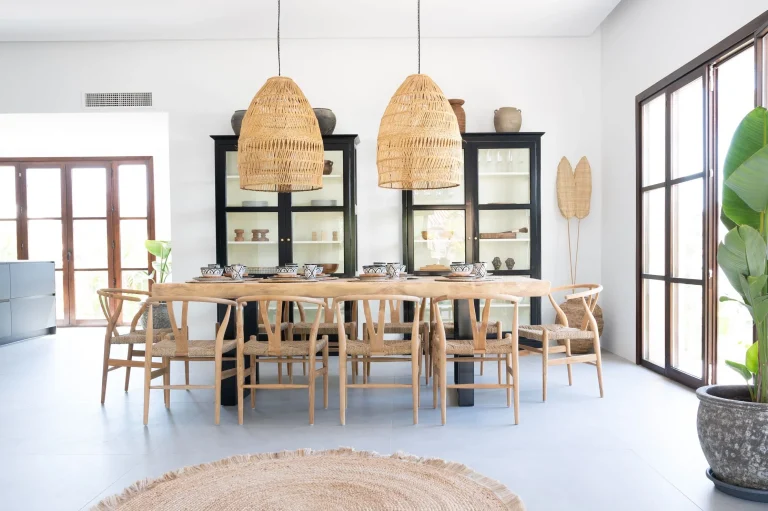The Wishbone chair CH24 is a timeless classic that’s been around for centuries. From the mind of Hans Wegner in 1949, this classic chair has a Y-shaped backrest and curved armrests, giving it a unique and graceful appearance.
The traditional chairs of China are an inspiration to the chair’s design, and it is also a symbol of Danish excellence in architecture. Look for a furniture store in USA , with its classic design and comfortable seats. Modern interior design shows the impact of Wishbone Chair, which brings sophistication and style into any room.
Let’s get started!
The Design of the Wishbone Chair
The Wishbone Chair or the Y Chair is a piece of furniture designed by a Danish designer, Hans Wegner, in 1949. The chair is characterized by a beautiful Y-shaped backrest, a curved backrest for support, and a sturdy wooden frame for comfort. The chair enjoys wide acceptance in both residential and commercial spaces for its immense popularity among architects and designers for the iconic silhouette and impeccable craftsmanship, thus, it is a beloved classic in furniture design.
History the Wishbone Chair
The Wishbone Chair, designed by the Dane designer Hans J. Wegner in 1949, is a standard of modern furniture, inspired by the classical Chinese chairs. It has a wooden seat and a paper cord woven seat, which is known for its classic design. The chair’s timelessness and comfort have made it a favorite piece to get Scandinavian design for interior spaces, making it a must-have in many living rooms and dining rooms.
The Wishbone Chair’s Influence
1. Origins and Design
In the first half of the 20th century, the Wishbone chair was invented by Hans Wegner, a Danish furniture designer. It’s called the “wishbone” because of its distinctive Y Shaped backrest. Wegner had a dream that the chair ought to be comfortable, elegant and useful.
2. Timeless Appeal
The Wishbone chair’s timeless style has come to represent mid century modern furniture. It is suitable for a variety of interior styles thanks to its elegant yet subtle form. The main selling point is its timeless appeal and simpleness.
3. Influence on Interior Design
The Wishbone Chair as a dining chair was the original purpose of its influence but it does not stop there. This is a popular choice among interior designers and they use it as a bold accent in living rooms, bedrooms and offices. Due to its diversity and understated elegance, it is one of the most preferred options for both residential and commercial areas.
4. Scandinavian Design Movement
The Wishbone Chair is the emblem of the Scandinavian design movement. The combination of minimalism, functionality, and craftsmanship, which are the key features of Scandinavian design, make the two very compatible. Wegner’s creation is the embodiment of Danish modernism and is one of the causes that have made Scandinavian design aesthetics be recognized worldwide.
5. Impact on Contemporary Furniture
The design of the Wishbone Chair has been the inspiration of many modern furniture pieces. Many designers find the organic forms and the use of natural materials in it as a source of inspiration. It can be seen in the modern chair designs that equally value style and comfort.
6. Cultural Significance
The Wishbone Chair bears cultural importance aside from design and functionality. It is the expression of the Danish design philosophy of simplicity, quality and craftsmanship. It is a symbol of Danish cultural heritage and pride of the nation.
7. Enduring Legacy
Decades after its creation the Wishbone Chair was captivated by design enthusiasts across the world. Its immortal design and cultural identity make it a part of design history. The chair’s legacy stands as proof to the lasting quality of carefully designed and crafted pieces.
The Wishbone Chair in Popular Culture
- Film and Television: The Wishbone Chair is the most popular and influential icon in modern and contemporary design. This chair has been seen in many movies and TV shows, showing its clean design and the characteristic shape of the chair in a well-rounded interior.
- Interior Design Magazines: The Eames chair is definitely a timeless design classic often seen in interior design magazines that serve as a source of inspiration for homeowners and designers alike. This emphasizes the timeless beauty and prestige of the design.
- Celebrity Homes: This chair has been featured in many celebrities’ and influencers’ houses. They published it both on social networks and in architectural magazines. This has been a significant factor influencing the item’s status as a luxury design.
- Design Exhibitions and Museums: This piece of modern furniture design has traveled extensively, being displayed in many exhibitions and museums around the globe, and thus being recognized for its cultural significance and impact on the design world.
- Design Blogs and Online Forums: A favorite design icon, is widely talked about on design blogs, forums, and social media by the enthusiasts, exchanging styling tips, comments, and DIY projects.
- Product Collaborations and Partnerships: The Wishbone Chair is the iconic design. It has been associated with famous designers, brands and shops. This has stimulated collecting and design groups. The brand achieved this by means of limited edition offerings.
- Cultural References and Iconography: The Wishbone Chair is a symbol of the mid-century modern design era. It is known worldwide for its unique shape and cultural value. It has molded art, literature and pop culture and it is going to live on for the future generations.
Conclusion
The Wishbone Chair combines form and function perfectly in the end. It is a synonym of Danish design. Its backrest is distinctive. It is shaped like a Y and is a regular Chinese seat. It played a significant role in the development of furniture designs. Its superb craftsmanship and enduring appeal are still the source of inspiration for the designers of the present all over the world.

